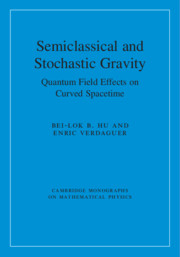Book contents
- Frontmatter
- Dedication
- Contents
- Preface
- 1 Overview: Main Themes. Key Issues. Reader’s Guide
- Part I Effective Action and Regularization, Stress Tensor and Fluctuations
- Part II Infrared Behavior, 2PI, I/N, Backreaction and Semiclassical Gravity
- 6 Infrared Behavior of Interacting Quantum Field
- 7 Advanced Field Theory Topics
- 8 Backreaction of Early Universe Quantum Processes
- Part III Stochastic Gravity
- Part IV Cosmological and Black Hole Backreaction with Fluctuations
- Part V Quantum Curvature Fluctuations in de Sitter Spacetime
- References
- Index
7 - Advanced Field Theory Topics
from Part II - Infrared Behavior, 2PI, I/N, Backreaction and Semiclassical Gravity
Published online by Cambridge University Press: 20 January 2020
- Frontmatter
- Dedication
- Contents
- Preface
- 1 Overview: Main Themes. Key Issues. Reader’s Guide
- Part I Effective Action and Regularization, Stress Tensor and Fluctuations
- Part II Infrared Behavior, 2PI, I/N, Backreaction and Semiclassical Gravity
- 6 Infrared Behavior of Interacting Quantum Field
- 7 Advanced Field Theory Topics
- 8 Backreaction of Early Universe Quantum Processes
- Part III Stochastic Gravity
- Part IV Cosmological and Black Hole Backreaction with Fluctuations
- Part V Quantum Curvature Fluctuations in de Sitter Spacetime
- References
- Index
Summary
In this chapter we construct the closed-time-path (CTP) two-particle-irreducible (2PI) effective action to two-loop order. The CTP formalism introduced in Chapter 3 is needed to track the dynamics of expectation values and to produce real and causal equations of motion. The composite particle or 2PI formalism introduced in Chapter 6 is needed to treat critical phenomena, because the correlation function and the mean field act as independent variables, instead of the former being a derivative of the latter, as in the 1PI formulation. The large N expansion has the advantage of yielding nonperturbative evolution equations in the regime of strong mean field and a covariantly conserved stress-energy tensor. To leading order in large N, the quantum effective action for the matter fields can be interpreted as a leading-order term in the expansion of the full matter plus gravity quantum effective action, which produces equations of motion for semiclassical gravity and, at the next-to-leading order in large N, stochastic gravity. Two types of quantum fields are treated: (a) O(N) self-interacting Phi-4 fields, and (b) Yukawa coupling between scalar and spinor fields, as an example of dealing with fermions in curved spacetime.
- Type
- Chapter
- Information
- Semiclassical and Stochastic GravityQuantum Field Effects on Curved Spacetime, pp. 228 - 264Publisher: Cambridge University PressPrint publication year: 2020

